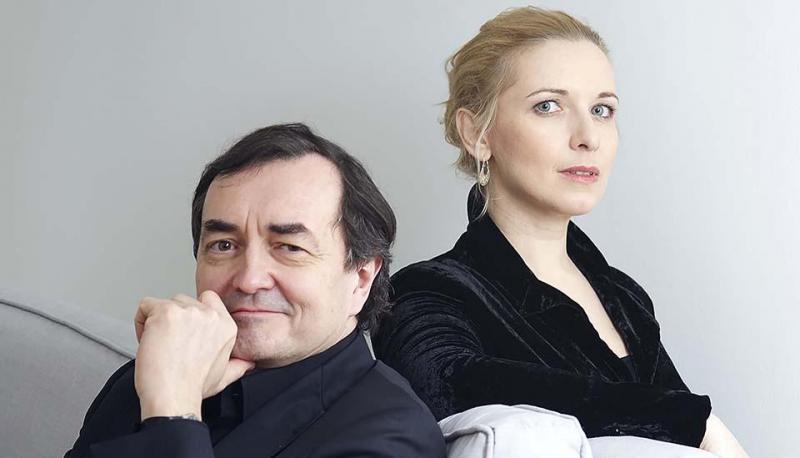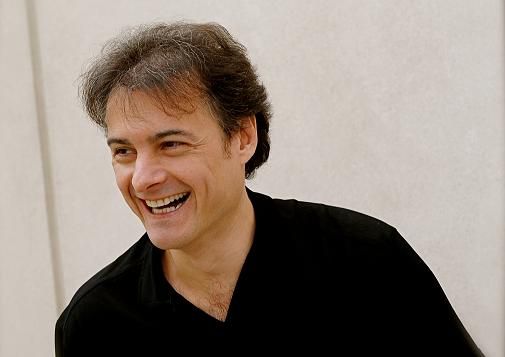Ligeti Chamber Music, QEH review - inventive celebration of iconic composer | reviews, news & interviews
Ligeti Chamber Music, QEH review - inventive celebration of iconic composer
Ligeti Chamber Music, QEH review - inventive celebration of iconic composer
Pierre-Laurent Aimard’s programming impresses as much as his playing

The mini-festival of György Ligeti’s music this weekend at the Queen Elizabeth Hall kicked off with a concert of chamber music that moved from a monumental first half to a second that was a delightful unbroken sequence of miniatures.
The two halves started with perhaps the two most archetypal minimalist pieces of all, Steve Reich’s Clapping Music and Ligeti’s Poème Symphonique. Reich’s piece is for two musicians alone (here Aimard himself with percussionist Daniel Ciampolini, pictured below), clapping a single rhythm that gets progressively further out of sync until it laps itself and gets back to unity. It is the most stripped-down expression of the technique Reich called "phasing", that has been a feature of his work for over 50 years. Ligeti’s ironically-named Poème Symphonique of 1962 (composed 10 years earlier than Clapping Music) takes the brilliantly simple idea of setting off 100 mechanical metronomes at the same time, all set to different tempos, to click away independently till they have all wound down. This creates a massive polyrhythm that moves in stages from the insistent rattle of all 100 playing together, through the gradual thinning out of the sound, to the final moments when the last two or three metronomes vie to outlast each other. It works both as a metaphor for society – every individual doing their own thing at the own speed, some burning out quickly, some doggedly keeping on – and as a sonic experience of the utmost complexity, from the simplest of materials. I was, as I always am, transfixed.
Ligeti’s ironically-named Poème Symphonique of 1962 (composed 10 years earlier than Clapping Music) takes the brilliantly simple idea of setting off 100 mechanical metronomes at the same time, all set to different tempos, to click away independently till they have all wound down. This creates a massive polyrhythm that moves in stages from the insistent rattle of all 100 playing together, through the gradual thinning out of the sound, to the final moments when the last two or three metronomes vie to outlast each other. It works both as a metaphor for society – every individual doing their own thing at the own speed, some burning out quickly, some doggedly keeping on – and as a sonic experience of the utmost complexity, from the simplest of materials. I was, as I always am, transfixed.
Aside from the Poème Symphonique, Ligeti’s response to minimalism was to play up its complexities – such as polyrhythm and layered processes – while avoiding the comforting consonances of Reich and Glass. The Three Pieces for Two Pianos are bracing and stern, although not without wit, in their unrelenting pursuit of single ideas. For these Aimard was joined by his regular duo partner Tamara Stefanovich, and they were well matched in their bright, precise sound. The second piece, “Self-portrait”, namechecks Reich and Terry Riley in its subtitle (as well as the hard-to-discern Chopin), but where the Americans are mellifluous and regular, Ligeti’s just-about-controlled chaos has a jerky, runaway quality. (I remember his music being described, I think by his biographer Richard Steinitz, as being like a car with square wheels careering downhill.) The heart of the concert, in two senses, was Ligeti’s Trio for Horn, Violin and Piano of 1982, which he himself said was the piece that opened the way to his late style. Described as a homage to Brahms (again, it is difficult to hear any connection), the trio has perhaps more humanity than other Ligeti: it is more alive to nuance and melody, and flirts with (although never gets into bed with) traditional tonality. It was sensitively played by Aimard, with exquisitely controlled horn player Marie-Luise Neunecker (pictured above) and mercurial, energetic violinist Patricia Kopatchinskaja. But for all its beguiling qualities, it is less exciting, less thrilling, safer than, say, the Chamber Concerto.
The heart of the concert, in two senses, was Ligeti’s Trio for Horn, Violin and Piano of 1982, which he himself said was the piece that opened the way to his late style. Described as a homage to Brahms (again, it is difficult to hear any connection), the trio has perhaps more humanity than other Ligeti: it is more alive to nuance and melody, and flirts with (although never gets into bed with) traditional tonality. It was sensitively played by Aimard, with exquisitely controlled horn player Marie-Luise Neunecker (pictured above) and mercurial, energetic violinist Patricia Kopatchinskaja. But for all its beguiling qualities, it is less exciting, less thrilling, safer than, say, the Chamber Concerto.
After the interval, Aimard came into his own as programmer. Running 25 minutes of music together without pause, he took us from Clapping Music to an improvisation on one of Ligeti’s late Études, for piano and percussion, via Conlon Nancarrow, the eccentric American whose works were first championed by Ligeti in the 1970s. Most fascinating was an improvisation on Poème Symphonique, involving both pianists, percussionist and both page-turners in improvising rhythmic pulses on the high end of two pianos, like living, breathing metronomes.
In the final improvisation, Aimard worked his way through Ligeti’s wonderful Étude No. 4 (Fanfares) accompanied by the charismatic Daniel Ciampolini first on congas, picking out cross-rhythms and canons, then on vibraphone, his sticks flying in a free cadenza of jaw-dropping speed. I am sure Ligeti would have approved.
rating
Explore topics
Share this article
The future of Arts Journalism
You can stop theartsdesk.com closing!
We urgently need financing to survive. Our fundraising drive has thus far raised £49,000 but we need to reach £100,000 or we will be forced to close. Please contribute here: https://gofund.me/c3f6033d
And if you can forward this information to anyone who might assist, we’d be grateful.

Subscribe to theartsdesk.com
Thank you for continuing to read our work on theartsdesk.com. For unlimited access to every article in its entirety, including our archive of more than 15,000 pieces, we're asking for £5 per month or £40 per year. We feel it's a very good deal, and hope you do too.
To take a subscription now simply click here.
And if you're looking for that extra gift for a friend or family member, why not treat them to a theartsdesk.com gift subscription?
more Classical music
 Goldscheider, Brother Tree Sound, Kings Place review - music of hope from a young composer
Unusual combination of horn, strings and electronics makes for some intriguing listening
Goldscheider, Brother Tree Sound, Kings Place review - music of hope from a young composer
Unusual combination of horn, strings and electronics makes for some intriguing listening
 Helleur-Simcock, Hallé, Wong, Bridgewater Hall, Manchester review - moving lyricism in Elgar’s concerto
Season opener brings lyrical beauty, crisp confidence and a proper Romantic wallow
Helleur-Simcock, Hallé, Wong, Bridgewater Hall, Manchester review - moving lyricism in Elgar’s concerto
Season opener brings lyrical beauty, crisp confidence and a proper Romantic wallow
 Kohout, Spence, Braun, Manchester Camerata, Huth, RNCM, Manchester review - joy, insight, imagination and unanimity
Celebration of the past with stars of the future at the Royal Northern College
Kohout, Spence, Braun, Manchester Camerata, Huth, RNCM, Manchester review - joy, insight, imagination and unanimity
Celebration of the past with stars of the future at the Royal Northern College
 Jansen, LSO, Pappano, Barbican review - profound and bracing emotional workouts
Great soloist, conductor and orchestra take Britten and Shostakovich to the edge
Jansen, LSO, Pappano, Barbican review - profound and bracing emotional workouts
Great soloist, conductor and orchestra take Britten and Shostakovich to the edge
 Jakub Hrůša and Friends in Concert, Royal Opera review - fleshcreep in two uneven halves
Bartók kept short, and a sprawling Dvořák choral ballad done as well as it could be
Jakub Hrůša and Friends in Concert, Royal Opera review - fleshcreep in two uneven halves
Bartók kept short, and a sprawling Dvořák choral ballad done as well as it could be
 Hadelich, BBC Philharmonic, Storgårds, Bridgewater Hall, Manchester review - youth, fate and pain
Prokofiev in the hands of a fine violinist has surely never sounded better
Hadelich, BBC Philharmonic, Storgårds, Bridgewater Hall, Manchester review - youth, fate and pain
Prokofiev in the hands of a fine violinist has surely never sounded better
 Monteverdi Choir, ORR, Heras-Casado, St Martin-in-the-Fields review - flames of joy and sorrow
First-rate soloists, choir and orchestra unite in a blazing Mozart Requiem
Monteverdi Choir, ORR, Heras-Casado, St Martin-in-the-Fields review - flames of joy and sorrow
First-rate soloists, choir and orchestra unite in a blazing Mozart Requiem
 Cho, LSO, Pappano, Barbican review - finely-focused stormy weather
Chameleonic Seong-Jin Cho is a match for the fine-tuning of the LSO’s Chief Conductor
Cho, LSO, Pappano, Barbican review - finely-focused stormy weather
Chameleonic Seong-Jin Cho is a match for the fine-tuning of the LSO’s Chief Conductor
 Classical CDs: Shrouds, silhouettes and superstition
Cello concertos, choral collections and a stunning tribute to a contemporary giant
Classical CDs: Shrouds, silhouettes and superstition
Cello concertos, choral collections and a stunning tribute to a contemporary giant
 Appl, Levickis, Wigmore Hall review - fun to the fore in cabaret and show songs
A relaxed evening of light-hearted fare, with the accordion offering unusual colours
Appl, Levickis, Wigmore Hall review - fun to the fore in cabaret and show songs
A relaxed evening of light-hearted fare, with the accordion offering unusual colours
 Lammermuir Festival 2025, Part 2 review - from the soaringly sublime to the zoologically ridiculous
Bigger than ever, and the quality remains astonishingly high
Lammermuir Festival 2025, Part 2 review - from the soaringly sublime to the zoologically ridiculous
Bigger than ever, and the quality remains astonishingly high
 BBC Proms: Ehnes, Sinfonia of London, Wilson review - aspects of love
Sensuous Ravel, and bittersweet Bernstein, on an amorous evening
BBC Proms: Ehnes, Sinfonia of London, Wilson review - aspects of love
Sensuous Ravel, and bittersweet Bernstein, on an amorous evening

Add comment